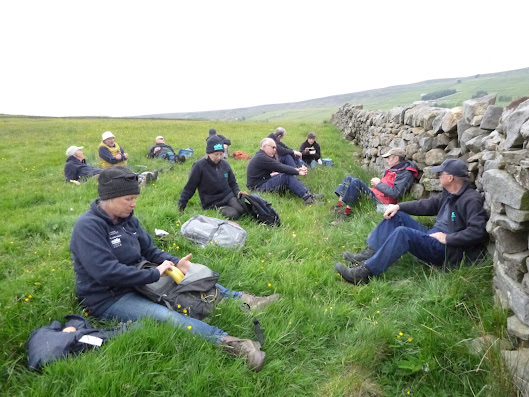Hay meadow restoration was the name of the game for the NCVs this week. There were 688 red clover plug plants waiting to be inserted into the pastures above Stean, so who better to insert them than a group of people who have had experience of this type of task on more than one previous occasion?
You may wonder why the focus was on red clover. A quick check on google revealed that because clover fixes nitrogen in its roots it reduces the need for artificial fertilizers. It also helps retain soil moisture and suppresses some
weeds, so fields need less water and herbicide. It also provides an excellent food supply for bees and other pollinators. This is, therefore, a win win situation with regard to the environment. Apparently red clover seedlings can withstand more shade than other legumes allowing it to become established more easily.
So - what did the task involve? Find out below....
The NCVs arrived in good time and
awaited the arrival of the clover plugs.
Apparently they were delayed in
transport by a slow moving vehicle.
Once they finally reached the upper
dale Claire explained the complicated plan
to insert them into just half of each field.
(See reason for this at the bottom of this entry.)
Instructions and recording lists were
given out...
.... and fields allocated.
Then the fun began.
First the plugs had to be coaxed out of
their trays with a pokey pen and
counted into trugs.
The water bottles had to be filled....
...and carried off ....
...to an allocated site,
which could have been faaaaar awaaaay.
Once there you had to dig holes to insert the plugs.
Trowels were provided but pick axes
would have been more appropriate.
This trowel came off worse in its battle
with the hard, dry ground.
A pen knife actually turned out to be the
tool of choice. With this you could remove
a clover plug sized grass plug very easily.
Once planted, each plug was carefully watered. Good luck little clover!
The teams moved from one suitable planting
plot to another, inserting 5 plugs
and listing the grid reference
for each stop.
The plan went like clockwork.
"Right ladies - over there next!"
Lunch was eaten in the shelter of a wall to
escape the chilly easterly wind.
As you can see by the headgear and coats,
the weather was MUCH colder than of late!!
All that remained to be done after lunch were 9
more plots by team 1 who, fortified by their dinner,
strode off to polish off the final plugs in no time flat.
One team claimed their plugs had
already flowered.
Don't think so! That was already there!
En route back to the cars Ros E. almost had her
nose pecked off by a baby blackbird. It had
suddenly swooped down across her path to land
in a hole in the wall - by pure chance NOT by design!!
* So - in case you are wondering - why only plant into half of each field?
This is the first part of an experiment. The second half of the fields will be planted up after the hotter part of the summer is over and the sheep are about to put onto them. This will, hopefully tell us if it is better to plant earlier (and risk little rainfall) or later (and risk being cropped by sheep).
So now you know!!




















No comments:
Post a Comment